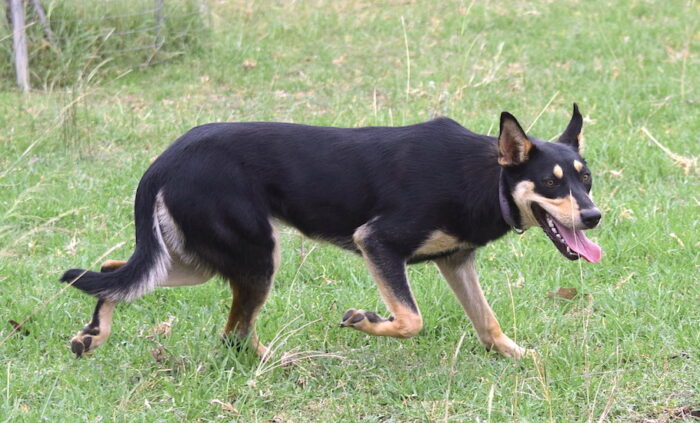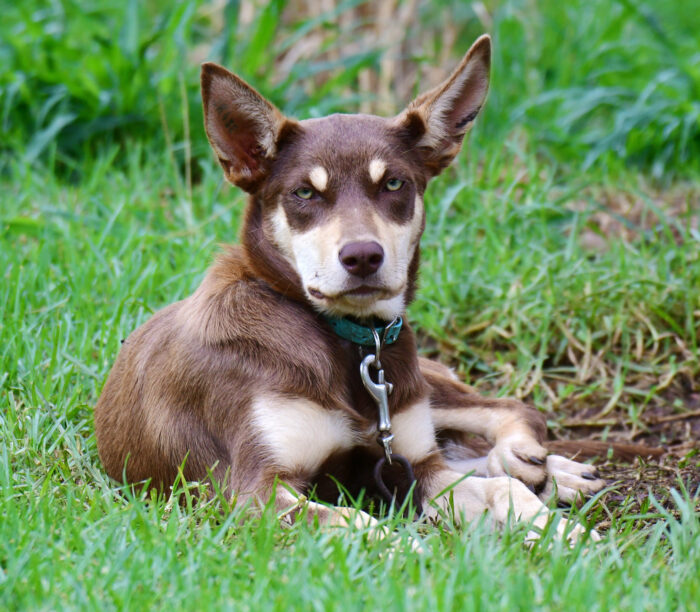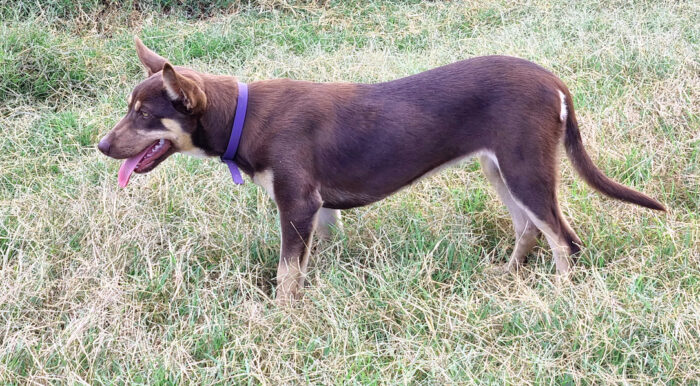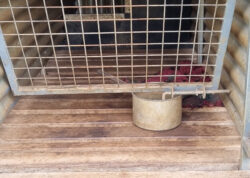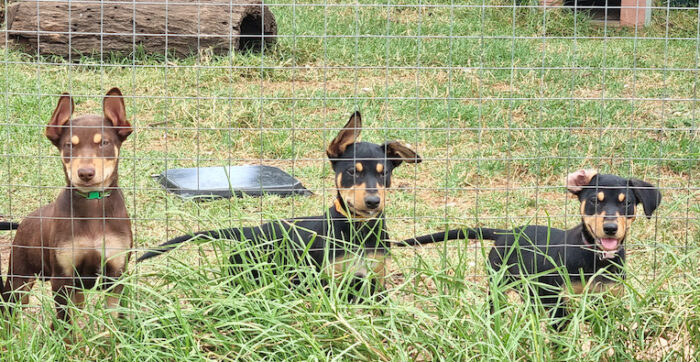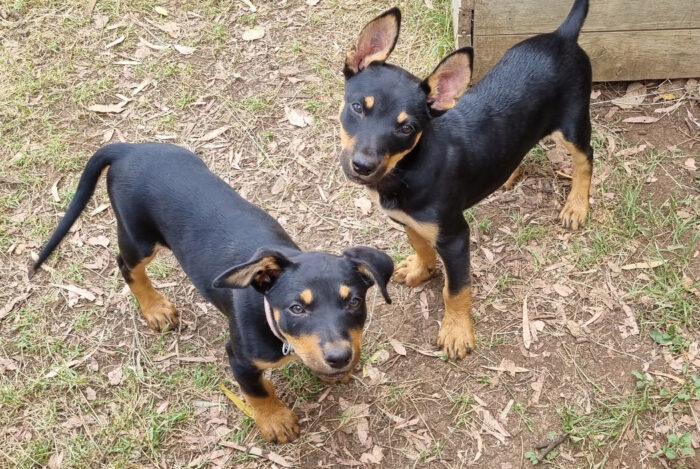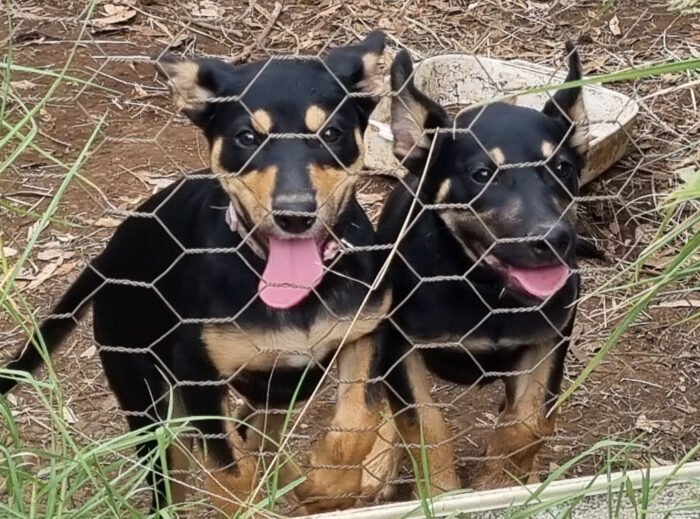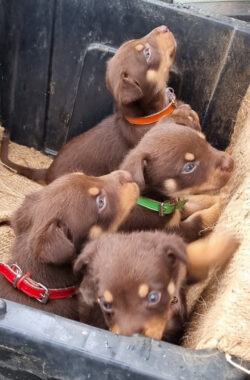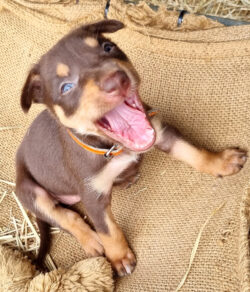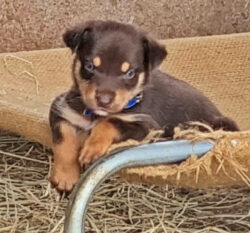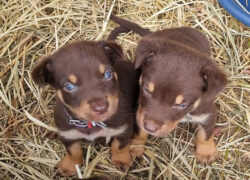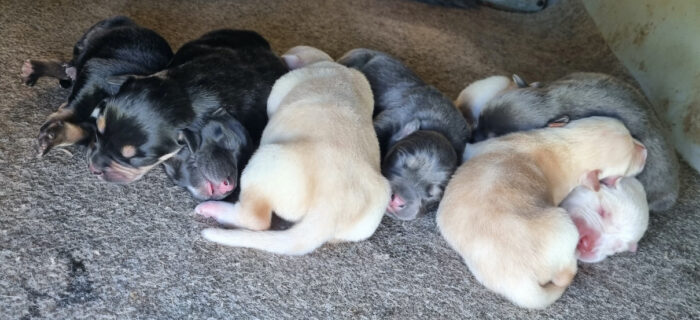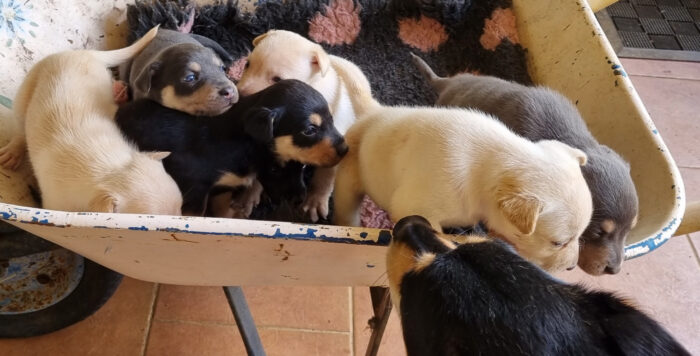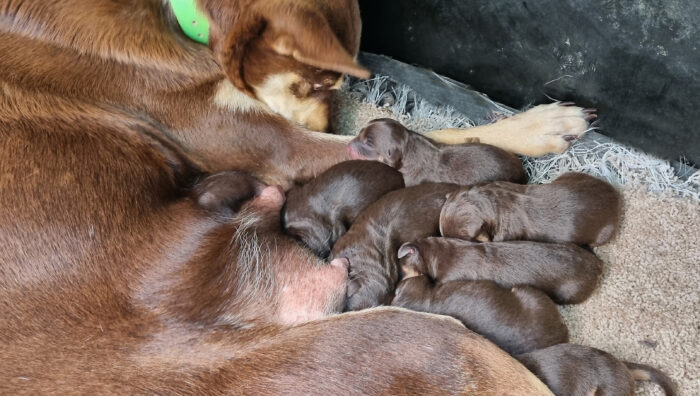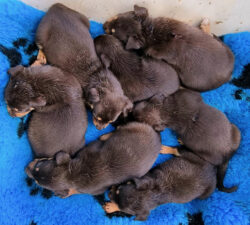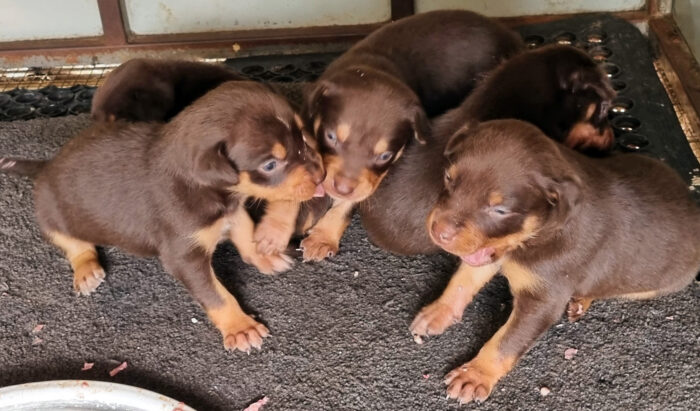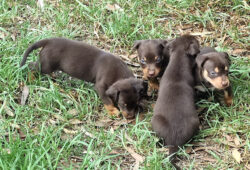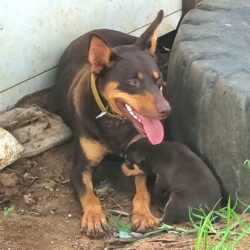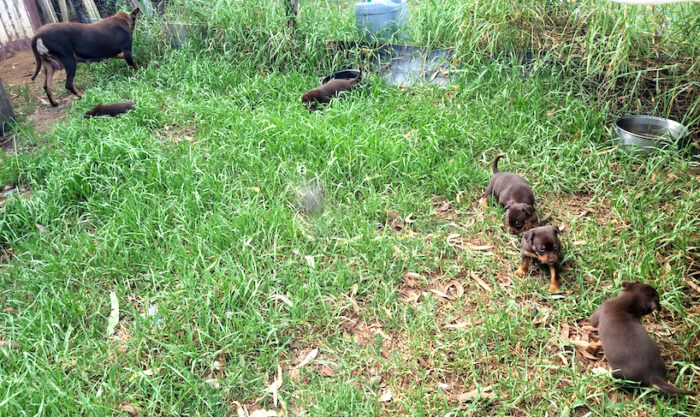February 2022
WARNING… this blog contains NO references to COVID 19, jabs or boosters!!! JUST DOGS!
Maybe we’re getting summer at last, it usually warms up when school goes back. 38’C on the back deck this arvo. It’s been a very cool summer here thank goodness. Little pups hate the heat but I’ve only had a couple of afternoons when I had to turn the big sprinkler on the kennels.
I just read this excellent piece on Facebook….posted by That Dog School. Those of you who work Kelpies and visit this blog regularly can skip it of course!
BUT…if you are wondering about asking me about getting a pup as a pet, please read all of it… I already have a very brief version on my Puppies for Sale page. This lady knows what she’s talking about.
𝗪𝗼𝗿𝗸𝗶𝗻𝗴 𝗞𝗲𝗹𝗽𝗶𝗲𝘀 𝗮𝘀 𝗣𝗲𝘁𝘀 ~ 𝑊ℎ𝑎𝑡 𝑦𝑜𝑢 𝑟𝑒𝑎𝑙𝑙𝑦 𝑛𝑒𝑒𝑑 𝑡𝑜 𝑘𝑛𝑜𝑤
📺 The recent release of the ABC tv series Muster Dogs, has placed a spotlight on an iconic Australian breed – the Kelpie.
🐕 If we have learnt anything from past film releases such as 101 Dalmatians, Eight Below, and Max, it is that the A list breed is about to get a real popularity boost in the eyes of the pet loving public
These shows and films utilise dogs that are either:
✅ Animated
✅ Mature aged and already very highly trained
✅ Young and under the training of a highly experienced handler
🤫 Unfortunately, clever editing, a feel good story line, and the general public’s love of dogs can blind a lot of people to the actual reality of living with the breed of dog in question.
😎 There is so much to love about the Kelpie, beyond their obvious athletic good looks.
➡️ As an owner of two Kelpies, I’m here to point out what’s good about them, what’s bad about them, and deliver a healthy dose of reality as to why these dogs are not for everyone.
𝘼𝙣 𝙄𝙢𝙥𝙤𝙧𝙩𝙖𝙣𝙩 𝘿𝙞𝙨𝙩𝙞𝙣𝙘𝙩𝙞𝙤𝙣
☝️The first thing I want to bring to your attention if you don’t already know, is that there are actually 𝘵𝘸𝘰 𝘥𝘪𝘧𝘧𝘦𝘳𝘦𝘯𝘵 𝘵𝘺𝘱𝘦𝘴 𝘰𝘧 𝘒𝘦𝘭𝘱𝘪𝘦.
🐕 The Kelpies in Muster Dogs are what we refer to as 𝑾𝒐𝒓𝒌𝒊𝒏𝒈 𝑳𝒊𝒏𝒆.
🇦🇺 The Working Kelpie is bred to work stock animals in the harsh and varied terrain of Australia.
✌️The second type of Kelpie is the 𝑩𝒆𝒏𝒄𝒉 𝒐𝒓 𝑺𝒉𝒐𝒘 𝑳𝒊𝒏𝒆 𝑲𝒆𝒍𝒑𝒊𝒆.
🐩 These dogs are shown in conformation competitions and are bred primarily for their appearance rather than any kind of work ability.
Think Koko from the movie Red Dog.
📏 Bench Kelpies are smaller in stature than the Working Kelpie. They are generally only found in solid black or red colouration, and, while still active, they are a little less relentlessly athletic than their working cousins.
🏃♀️ If you are not a staunch Working Kelpie connoisseur, a show Kelpie can make a really fun suburban pet for someone that just wants a nice compact dog to run and be active with.
🤓 The remainder of this post will be focusing on the Working Line Kelpie.
💭 My love affair with the Kelpie began when I was 12 years old.
📕 I was gifted a copy of the book Red Dog, and I was so seduced by the story of this Australian legend that I knew one day I would have a Kelpie of my own.
🗓 That one day was 10 years later, when I got my first Kelpie.
At the time I knew next to nothing about the right questions to ask, and was just excited to finally be making my dream come true.
🤕 I’d always read how hardy the breed is, and had no idea that these dogs could come with some pretty significant health issues.
What a hard learnt lesson that was.
🩺 Dog breeds more commonly recognised and bred to be pets are more likely to have stringent health standards that good breeders stick to.
They will test parents and resulting litters for various breed specific genetically inherited diseases.
🧬 The country working dog world has been a little slower on the uptake of genetic health testing.
😔 I just so happened to have the misfortune of buying from one such breeder.
I love my dog and wouldn’t trade him for the world, but at a relatively young age he was diagnosed with both Epilepsy and Hip Dysplasia.
👩⚕️ Prior to Hamlet’s diagnosis, I had no idea just how commonly these conditions occurred in Working Kelpies.
💪These dogs are tough! They are incredibly driven to work, and this drive will often cause them to mask the pain of serious underlying health issues.
🏥 It is easy for a stock dog breeder to believe that their breeding dogs are completely healthy, simply based on the fact that the dog does not show obvious signs of physical distress while working.
💰 If purchasing one of these dogs, I recommend asking your breeder about their stance on health testing, specifically probing into the health history of the potential parents of your puppy.
𝗖𝗵𝗼𝗼𝘀𝗶𝗻𝗴 𝗮 𝗕𝗿𝗲𝗲𝗱𝗲𝗿
👤 No one knows these dogs better than the person that lives and works with them day in and day out.
Working dogs breeders can vary hugely in the requirements they set for their own personal dogs. This will depend on things like the stock they work and the terrain they work on, this then drives the outcomes of their breedings.
👏 You 𝒎𝒖𝒔𝒕 be honest and upfront about your capabilities.
Don’t lie about your past dog experience and don’t lie about your living circumstances.
Tell your breeder:
✅ What you are looking for in a dog – helpful hint: this should not include your preferred coat colour.
✅ The other people and animals the dog will be expected to live with.
✅ The future purpose you have for it – hobby herder/agility/jogging companion/family pet etc.
✅ The amount of time and effort you envision being able to devote to the dog.
❓You should also ask them a bit about their standards. What factors they are breeding for in terms of working behaviour, temperament, sociability etc.
🐕➕🐕 A highly skilled working father paired with a highly skilled working mother does not immediately equal an entire litter of highly skilled puppies.
ℹ️ If you are honest with the breeder, they will be able to identify the puppies in a litter (if any) with average potential for work, and they may be able to accomodate your request for a sport dog or active family companion.
🔜 However, don’t expect this to happen immediately and don’t be offended if they plainly tell you no.
🤷♀️ Some people just do not have the current means or motivation to really provide for a working dog.
If a breeder feels you are not a good fit for the dogs they are producing, don’t take it personally.
🙏 Be grateful they are honest, because they could just take your money.
𝗚𝗼𝗶𝗻𝗴 𝗧𝗵𝗿𝗼𝘂𝗴𝗵 𝗥𝗲𝘀𝗰𝘂𝗲
🥇Kelpies are hugely popular even without the influence of shows like Muster Dogs.
Go to any local shelter or look up private rescue groups on Facebook and they are a dime a dozen.
☑️ Getting a Kelpie through rescue is always best done with a specialist organisation.
Places like Dogs4Jobs or Australian Working Dog Rescue are operated by very knowledgeable people who specialise in herding type dogs.
🏡 They will often find themselves taking in failed working dogs that couldn’t meet the requirements of working life on the farm.
These organisations will be able to more accurately assess the dogs in their care to be placed in the most compatible homes.
🐶 If you are a pet person in love with the Working Kelpie, this could be a good avenue for you.
𝙄𝙨 𝘼𝙡𝙡 𝙏𝙝𝙚 𝙃𝙮𝙥𝙚 𝙍𝙚𝙖𝙡𝙡𝙮 𝙉𝙚𝙘𝙚𝙨𝙨𝙖𝙧𝙮
🙄 At this point I can almost hear peoples eyes rolling in their heads.
“ 𝐶𝑜𝑚𝑒 𝑜𝑛 𝐽𝑢𝑙𝑖𝑎, 𝑡ℎ𝑖𝑠 𝑎𝑙𝑙 𝑠𝑒𝑒𝑚𝑠 𝑎 𝑏𝑖𝑡 𝑒𝑥𝑐𝑒𝑠𝑠𝑖𝑣𝑒 𝑓𝑜𝑟 𝑎 𝑑𝑜𝑔. 𝐼’𝑣𝑒 𝑜𝑤𝑛𝑒𝑑 𝑑𝑜𝑔𝑠 𝑏𝑒𝑓𝑜𝑟𝑒.”
🛋 There are the people who will say “I had a Kelpie for x amount of years and it was a lazy couch potato”.
📖 Breed standards exist for a reason, but yes, there will be the odd exception to the rule. That is no excuse to dive in blind because the dog you saw on tv was so amazing.
🤔 Taking on the responsibility of any animal is a significant commitment that should be considered carefully.
𝙇𝙚𝙨𝙨𝙤𝙣𝙨 𝙄’𝙫𝙚 𝙡𝙚𝙖𝙧𝙣𝙩 𝙡𝙞𝙫𝙞𝙣𝙜 𝙬𝙞𝙩𝙝 𝙖𝙣𝙙 𝙩𝙧𝙖𝙞𝙣𝙞𝙣𝙜 𝙒𝙤𝙧𝙠𝙞𝙣𝙜 𝙆𝙚𝙡𝙥𝙞𝙚𝙨.
1️⃣ 𝘛𝘩𝘦𝘺 𝘸𝘪𝘭𝘭 𝘢𝘭𝘸𝘢𝘺𝘴 𝘩𝘢𝘷𝘦 𝘮𝘰𝘳𝘦 𝘱𝘦𝘳𝘴𝘦𝘷𝘦𝘳𝘢𝘯𝘤𝘦 𝘵𝘩𝘢𝘯 𝘺𝘰𝘶.
💥 These dogs are bred to have grit and determination like no other.
Boy do they love a challenge!
🙃 It is a long, painful, and often fruitless experience to force a Kelpie to behave the way you want them to.
💡 You must get really good at understanding what motivates your dog, and then manufacturing training scenarios in which your Kelpie thinks the behaviour was their idea in the first place.
2️⃣ 𝘗𝘩𝘺𝘴𝘪𝘤𝘢𝘭 𝘦𝘹𝘦𝘳𝘤𝘪𝘴𝘦 𝘪𝘴 𝘰𝘷𝘦𝘳𝘳𝘢𝘵𝘦𝘥.
🙅♀️ A common misconception about working breeds is that they need heaps of exercise. Sure it has its place in a well adjusted dog, but it is not the be all and end all.
👉 Barking? Digging in the garden? Escaping the yard?
It just needs more exercise.
❗️Wrong!
Mental fatigue is so important for these dogs.
💤 If all you do is condition your kelpie to exercise, as the dog matures it becomes more and more difficult to tire it.
The dog is constantly switched on and seeking the next thing to do.
🧘♀️ For any dog, but especially our working Kelpies, we should be spending time early on teaching them how to switch off and cope with periods of boredom.
3️⃣ 𝘔𝘶𝘴𝘵 𝘭𝘰𝘷𝘦 𝘣𝘢𝘳𝘬𝘪𝘯𝘨.
👉 There will be exceptions to every rule, but it is normal for Working Kelpies to bark 𝘢 𝘭𝘰𝘵!
⚠️ This can be made exponentially worse when we factor in their high sensitivity to novelty.
🛹 Alert barking is not something you will erase completely. However, it goes a long way to spend plenty of time familiarising your dog in a positive way with new and novel experiences while they are young.
🏙 Teaching them how to be resilient in an ever changing suburban environment will reduce some of the hysteria they might otherwise develop if they feel the need to notify you of every dropping leaf and walking dog in the neighbourhood.
4️⃣ 𝘋𝘰𝘨 𝘱𝘢𝘳𝘬𝘴 𝘢𝘯𝘥 𝘋𝘢𝘺𝘤𝘢𝘳𝘦𝘴 𝘢𝘳𝘦 𝘯𝘰𝘵 𝘺𝘰𝘶𝘳 𝘧𝘳𝘪𝘦𝘯𝘥.
😅 Ok, so it’s no secret that I have long hated dog parks. I don’t recommend them to anybody.
For Working Kelpies this is especially the case.
👮♀️ Working dogs thrive on order and control. They are bred to identify disorder in an environment and bring it under wraps.
👀 𝑻𝒉𝒆 𝒖𝒍𝒕𝒊𝒎𝒂𝒕𝒆 𝒎𝒊𝒄𝒓𝒐𝒎𝒂𝒏𝒂𝒈𝒆𝒓𝒔.
🤪 Anyone who has been to a dog park will know it is hardly an orderly place.
🐑 For a purpose bred Working Kelpie, this becomes the perfect opportunity to tap into its unfulfilled herding instincts and work the other dogs around it.
💁♀️ This is incredibly satisfying for them, and it is often not discouraged by the humans around because “he’s just doing what a herding dog does”.
🤯 When given free reign to “play” this way, with no control or parameters set by the handler, they quickly begin to experience frustration when they go walking on the lead and see dogs on the street that are out of their sphere of influence.
🌋 When the leash blocks their access to their usual source of fun, the frustration and arousal can become a frightening combination that leads to many troubling behaviours directed at these other dogs.
4️⃣ 𝘛𝘩𝘦 𝘳𝘦𝘭𝘢𝘵𝘪𝘰𝘯𝘴𝘩𝘪𝘱 𝘵𝘢𝘬𝘦𝘴 𝘸𝘰𝘳𝘬.
🥰 If you want a dog that will naturally fawn all over you, look elsewhere.
🙌 A bond with one of these dogs is incredibly rewarding, but it does not come cheap.
They have enough of an independent streak, that they will happily satisfy themselves elsewhere if you are not investing in them.
💟 I’m a dog trainer and have been a general Working Kelpie enthusiast for many years.
I knew full well what to expect by the time I added my second Kelpie to the mix (thanks Clermont Kelpies).
😅 Still, they test me on a personal and professional level every day and I love the challenge, but some days even I just want to pull my hair out.
❤️🔥 They have certainly made me a better dog handler, but they are not for the faint of heart.
👨👩👧 If you’re a normal suburban pet dog owner who has their heart set on a Kelpie and nothing will dissuade you, where to from here?
⭐️ Understand that a 𝒑𝒖𝒓𝒑𝒐𝒔𝒆 𝒃𝒓𝒆𝒅 Working Kelpie, the likes of which you see on Muster Dogs, is there to fill a highly specific need.
These dogs carry their working ability in their very genes and pass these traits on to their offspring.
💯 In my opinion, at the end of the day very few of these dogs actually make suitable suburban pets, and that is just the honest truth.
⭐️ Do some reading up on Bench versus Working Kelpies. Consider whether one may be better suited to your lifestyle than the other.
⭐️ Look into reputable breeders and/or responsible rescue organisations.
⭐️ Listen to the professionals around you. Take your time and don’t insist on taking home the first dog/puppy you meet.
⭐️ Invest in training straight away.
Whether you are taking on a puppy or a mature aged dog, herding breeds have behavioural quirks and physical/mental needs that require understanding.
Get in touch with a qualified dog trainer to help you get off on the right foot with your new dog.
********************************************************************************************************
These two videos are of the oldest of the pups I’m running on having their first look at sheep at 4 months….in a 5ac paddock! Just a quick look to see if I’d sell them. Arthur used to try pups on a mob of killers in a 100 ac paddock so when he says quite calmly, “Well, we’ll just let her go…” I must admit I wondered what would happen, but both pups controlled the sheep well.
Min is a bit too smart for her own good…she’s done this twice…after mastering the sliding bolt and being moved to high security she also worked this out. I’d never had to use the bolt before but will need to if she’s to have any teeth left!
The next age of pups is about 12 weeks, they’re still here because I always run on a couple from each litter that I like best…and a couple are waiting for their buyers to collect them.
Brass, Kuss and Poss from the Brock x Gossip litter
The two keepers from Wills x Midnight, Curie and Creed. Another pair from this litter is headed over to the Pilbara to join a big brother, Banjo, who is working very well.
Charisma and Bril (Brock x Glam) another nice pair.
And so to the little ones! They grow so fast so one photo from early Jan. and recent ones. Sass first.
These puppies born 31/12/21
Next lot, Heli on 1/1/22 a nice lot of colours, they’ve done very well.
Bimber was meant to be having a rest but she decided otherwise…. born 5/1/22
And last cab off the rank was Mustard!
I moved her pups out into a yard today but she jumped out and had a dip in my little garden ‘pond’…..!
Feb.24: Some sad news. Tim had to be put down this week with a stomach cancer. Vale a very brave dog who did his best to please even when in pain.
